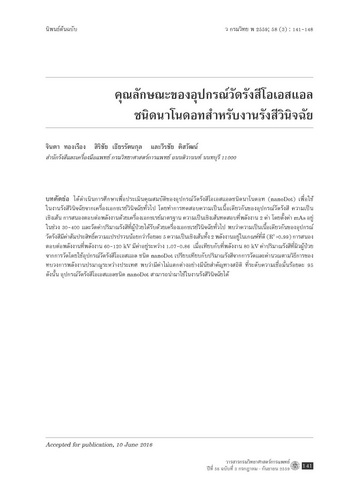Characterization of an Optically Stimulated Luminescence NanoDot Dosimeters for Diagnostic Radiology
Abstract
Characterization of an optically stimulated luminescence, nanoDot dosimeters, using in conventional diagnostic radiology was evaluated. The homogeneity, linearity and energy response of the nanoDot dosimeters were tested by using GE standard x-ray generator. For the linearity, two energies were tested with a range of mAs from 30 to 400. The entrance skin dose was measured and compared with the data obtained with detector, IAEA protocol, using diagnostic conventional x-ray generator. Batch homogeneity showed a coefficient of variation of < 5%. Linearity results at both energies showed good linearity (R2 > 0.99). Energy response study showed a range of ratios between 1.07 and 0.86, at the energies investigated 60-120 kV. Dose difference between the dose measurements using nanoDot dosimeters and the dose calculated by using IAEA protocol showed no significant variation at a confidence level of 95%. The optically stimulated luminescence nanoDot dosimeters can be used in diagnostic radiography.
References
International Atomic Energy Agency. Dosimetry in diagnostic radiology: an international code of practice. Technical reports series no. 457. Vienna: IAEA; 2007.
Jursinic PA. Characterization of optically stimulated luminescent dosimeters, OSLDs, for clinical dosimetric measurements. Med Phys 2007; 34(12): 4594-604.
Lehmann J, Dunn L, Lye JE, Kenny JW, Alves AD, Cole A, et al. Angular dependence of the response of the nanoDot OSLD system for measurements at depth in clinical megavoltage beams. Med Phys 2014; 41(6): 061712 [1-9].
Viamonte A, da Rosa LA, Buckley LA, Cherpak A, Cygler JE. Radiotherapy dosimetry using a commercial OSL system. Med Phys 2008; 35(4):1261-6.
Kobayashi I, Okazaki T, Yajima K, Yasuda H. Environmental radiation dosimetry by the small OSL reader. Progress Nucl Sci Technol 2012; 3: 79-81.
Yusuf M, Saoudi A, Alothmany N, Alothmany D, Natto H, Natto S, et al. Characterization of the optically stimulated luminescence nanoDot for CT dosimetry. Life Sci J 2014; 11(2): 445-50.
Endo A, Katoh T, Vasudeva SB, Kobayashi I, Okano T. A preliminary study to determine the diagnostic reference level using dose-area product for limited-area cone beam CT. Dentomaxillofac Radiol 2013; 42(4): 20120097 [1-6].
Perks CA, Yahnke C, Million M. Medical dosimetry using optically stimulated luminescence dots and micro Star reader. [online]. [10 screens]. Available from: URL: https://www.iaea.org/inis/collection/NCLCollectionStore/_Public/40/108/40108739.pdf
International Commission on Radiological Protection. Recommendations of the international commission on radiological protection, ICRP publication 103. UK: ICRP; 2007.
กองรังสีและเครื่องมือแพทย์. กรมวิทยาศาสตร์การแพทย์. ประกาศกรมวิทยาศาสตร์การแพทย์ เรื่อง ข้อปฏิบัติการควบคุมคุณภาพเครื่องเอกซเรย์วินิจฉัย. [ออนไลน์]. 2550 [22 หน้า]. เข้าถึงได้ที่ : URL: https://www.dmsc.moph.go.th/dmsc/userfiles/files/QAXray.pdf
Al-Senan RM, Hatab MR. Characteristics of an OSLD in the diagnostic energy range. Med Phys 2011; 38(7): 4396-405.
Danzer J, Dudney C, Seibert R, Robinson B, Harris C, Ramsey C. Optically stimulated luminescence of aluminum oxide detectors for radiation therapy quality assurance. 49th Annual Meeting of the AAPM; 2007 Jul 22-26. Minneapolis, Minnesota: AAPM; 2007.

Downloads
Published
How to Cite
Issue
Section
License

This work is licensed under a Creative Commons Attribution-NonCommercial-NoDerivatives 4.0 International License.



